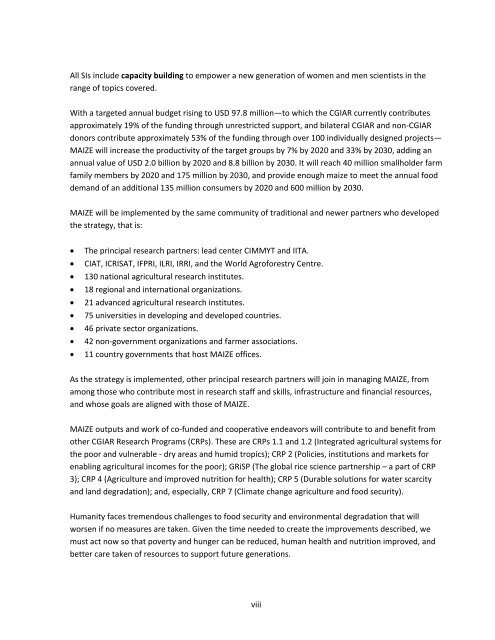Download - Maize
Download - Maize
Download - Maize
You also want an ePaper? Increase the reach of your titles
YUMPU automatically turns print PDFs into web optimized ePapers that Google loves.
All SIs include capacity building to empower a new generation of women and men scientists in the<br />
range of topics covered.<br />
With a targeted annual budget rising to USD 97.8 million―to which the CGIAR currently contributes<br />
approximately 19% of the funding through unrestricted support, and bilateral CGIAR and non‐CGIAR<br />
donors contribute approximately 53% of the funding through over 100 individually designed projects―<br />
MAIZE will increase the productivity of the target groups by 7% by 2020 and 33% by 2030, adding an<br />
annual value of USD 2.0 billion by 2020 and 8.8 billion by 2030. It will reach 40 million smallholder farm<br />
family members by 2020 and 175 million by 2030, and provide enough maize to meet the annual food<br />
demand of an additional 135 million consumers by 2020 and 600 million by 2030.<br />
MAIZE will be implemented by the same community of traditional and newer partners who developed<br />
the strategy, that is:<br />
<br />
<br />
<br />
<br />
<br />
<br />
<br />
<br />
<br />
The principal research partners: lead center CIMMYT and IITA.<br />
CIAT, ICRISAT, IFPRI, ILRI, IRRI, and the World Agroforestry Centre.<br />
130 national agricultural research institutes.<br />
18 regional and international organizations.<br />
21 advanced agricultural research institutes.<br />
75 universities in developing and developed countries.<br />
46 private sector organizations.<br />
42 non‐government organizations and farmer associations.<br />
11 country governments that host MAIZE offices.<br />
As the strategy is implemented, other principal research partners will join in managing MAIZE, from<br />
among those who contribute most in research staff and skills, infrastructure and financial resources,<br />
and whose goals are aligned with those of MAIZE.<br />
MAIZE outputs and work of co‐funded and cooperative endeavors will contribute to and benefit from<br />
other CGIAR Research Programs (CRPs). These are CRPs 1.1 and 1.2 (Integrated agricultural systems for<br />
the poor and vulnerable ‐ dry areas and humid tropics); CRP 2 (Policies, institutions and markets for<br />
enabling agricultural incomes for the poor); GRiSP (The global rice science partnership – a part of CRP<br />
3); CRP 4 (Agriculture and improved nutrition for health); CRP 5 (Durable solutions for water scarcity<br />
and land degradation); and, especially, CRP 7 (Climate change agriculture and food security).<br />
Humanity faces tremendous challenges to food security and environmental degradation that will<br />
worsen if no measures are taken. Given the time needed to create the improvements described, we<br />
must act now so that poverty and hunger can be reduced, human health and nutrition improved, and<br />
better care taken of resources to support future generations.<br />
viii

















